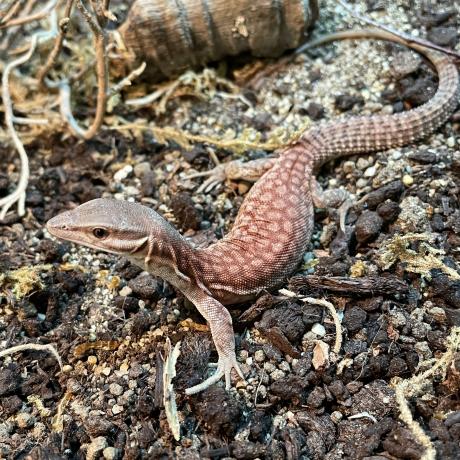

The Ridge Tailed Monitor is also known as an Ackie Monitor within the pet trade. These are much smaller compared to other species of monitors reaching no more than two feet in total length.
| Origin | Northern Australia |
|---|---|
| Environment | Arid and desert regions |
| Adult Size | Up to 2 foot |
| Suitability | Intermediate |
| Lifespan | 15 - 20 years |
| Temperament | Calm |
The appearance of the Ridge Tailed Monitor is typical of a monitor species. They have an elongated body and neck, average tail length, short limbs and a pointed head and snout. The tongue is used in the same manner as a snake, this is forked and flicked out to taste the environment around them using the ‘Jacobson's organ’ The skin is rough to the touch and the tail has rings of small spikes, giving them their common name.
There are two colour forms in captivity; red and yellow form. The red is rarely available, but its colour is more intense and they do grow slightly larger. The yellow form is the one you mainly see within the pet trade. These have a brown base colour, with light cream to yellow spots along the whole body. The adult size varies depending on the sex of the animal. Female are slightly smaller at a total length of 16-18 inches (40.5-48cm), males are larger at around 24 inches (61 cm). The average snout to vent length is 7-10 inches (18-25.5cm).
The Ridge Tailed Monitors native habitat is flat terrain in the hot arid desert of Northern Australia. They live near rocky outcrops and will use crevices and burrows to escape predators and the daytime heat.
An essential piece of advice when choosing how many monitors to keep. If you are wanting to keep a couple together, you must purchase these at a young age and ideally from the same group. Ridge Tailed Monitors can be very territorial, not just the males fighting but females in a higher hierarchy. Introducing extra animals to an established animal or group will likely result in injury and possible death.
Ridge Tailed Monitors need a spacious enclosure to allow the high temperatures they require along with plenty of roaming space. To house one adult, we would recommend a 4x2x2ft vivarium, if you are wanting to keep more together, go for at least 5x2x2ft or better still a 6x2x2ft.
Provide a high basking area that reaches 55-60C (131-140F) directly under the heat source. The use of spotlights, halogen or deep heat projectors connected to a Dimming High Range Thermostat is ideal. The Monitors will only bask for short periods then move away, proving lower temperatures risk the animals burning their skin as they will sit under the bulb for a longer period of time. The ambient air temperature should be maintained at 25-28C (77-82.5F). Nighttime temperatures need to be lowered down to 22-25C (35.5-77F) which can be maintained using a ceramic heater connected to a thermostat. Both bulbs/ceramics must be protected by guards as the monitors will jump up and burn themselves.
Due to the nature of this species, they require a higher UVB output. They are classed as a zone 4 on the Ferguson scale which is related to a T5 14%. This should be turned on for around 8-12 hours per day depending on the season.
This species likes to burrow in the substrate, therefore we recommend having at least 6 inches (15cm) depth. This can be made up with a sand and soil mix, this should help keep the texture and prevent the burrows from caving in. The use of cork bark tubes placed in the substrate will help stimulate their natural behaviour. The only downside to this, if you need to get the animal out to do a health check, you may have to turn the enclosure upside down to get to them!
Ridge Tailed Monitors are very active and love to climb and hide within rocks and crevices. We have found that using a number of cork bark pieces and branches keeps them active and from becoming obese. The use of artificial plants will give some colour to the enclosure, live plants can be used, but go for hardy desert species and provide them with a LED plant light.
These Monitors have a high metabolism, therefore, require more food compared to other reptiles. Babies and growing monitors should be fed daily, adults can be fed at least five times a week. They will feed on a range of foods from live insects, eggs, defrosted rodents such as mice and the Repashy Meat Pie. Always provide calcium and vitamin supplements to the foods. Freshwater should always be available and we recommend spraying the substrate once a week to increase the humidity levels, the Monitors themselves prefer not to be sprayed.